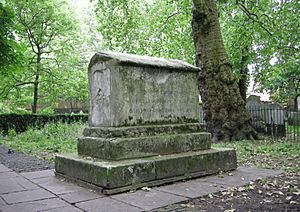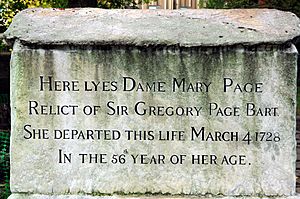Sir Gregory Page, 1st Baronet facts for kids
Sir Gregory Page, 1st Baronet (born around 1669 – died May 25, 1720), was an important English businessman and politician from Greenwich, Kent. He made a lot of money as a brewer and merchant, trading goods from far-off places. He was also a member of the Whig political party and served in the British Parliament from 1708 until his death in 1720.
Contents
Early Life of Sir Gregory Page
Gregory Page was born around 1669. His father, also named Gregory Page, was a very rich merchant in London who owned a brewery. He also helped run the British East India Company, which was a big trading company. Gregory's father was an important official in the City of London in 1687.
On January 21, 1690, young Gregory Page married Mary Trotman. She was 17 years old and came from a London family.
Sir Gregory Page's Career
Sir Gregory Page followed in his father's footsteps, becoming a brewer and a merchant. He became very wealthy through trade, especially with countries in South and East Asia.
Working with the East India Company
From 1706 to 1708, he was part of a special committee for the Old East India Company. Later, he became a director of the East India Company from 1709 to 1712, and again from 1713 to 1715. This shows how important he was in the world of trade.
Becoming a Member of Parliament
In December 1708, Sir Gregory was chosen to be a Member of Parliament for New Shoreham in West Sussex. This area was known for shipbuilding. As a Whig politician, he voted on important issues. For example, in 1709, he supported allowing people from a region called Palatine to become British citizens. He also supported the impeachment (a formal accusation of wrongdoing) of a person named Dr. Sacheverell in 1710.
He was re-elected as an MP for Shoreham in 1710. On December 3, 1714, he was given the special title of Baronet, which is a hereditary honor.
Supporting the Government
Sir Gregory Page was elected MP for New Shoreham again in 1715. From then on, he supported the government led by the Hanoverian family. In 1716, he also became a director of the Royal Hospital Greenwich, a position he held for the rest of his life.
Personal Life and Family
Sir Gregory Page passed away on May 25, 1720, when he was about 50 years old. He was buried in Greenwich on June 2, 1720. He left behind four children: two sons named Gregory and Thomas, and two daughters named Mary and Sophia.
His eldest son, also named Gregory, inherited his father's title and his very large fortune. Sir Gregory's wife, Mary, died later on March 4, 1729, at the age of 55. She was buried in a special vault at Bunhill Fields in London. Her tombstone mentions that she had a very serious illness and underwent many medical procedures, showing her bravery.
Images for kids







